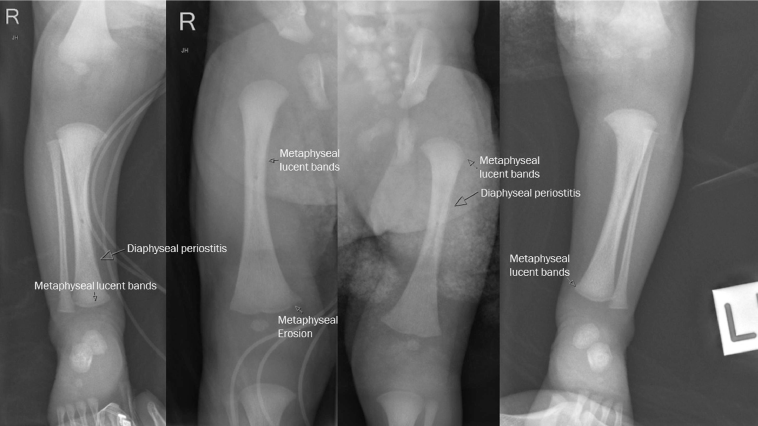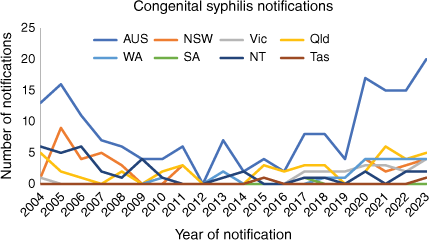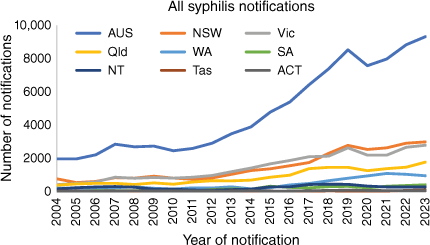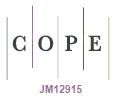Illuminating a dark field: a case of congenital syphilis in the context of rising rates in Australia and implications for screening guidelines
James M. Montgomery A * , Amanda Robinson B and Archana Koirala A CA
B
C
Abstract
To describe the changing landscape of congenital syphilis.
We present a case report of congenital syphilis, highlighting some of the challenges in management, and placing it within the broader public health context of rising syphilis rates.
This article is a brief case report in the context of a broader narrative review of congenital syphilis, including clinical significance, recent epidemiological trends in Australia and evolving recommendations on screening.
The rising rates of infectious syphilis across Australia, specifically an increase in incidence amongst non-Indigenous and Indigenous females of 22 and 11% respectively across 2023, is associated with an increase in congenital syphilis diagnoses. Concerningly, more diagnoses are occurring late in pregnancy, with 79% of reported cases since 2016 being either post-delivery or within the 30 days prior. The 10 deaths reported in 2023 from congenital syphilis is the highest number of deaths ever recorded in Australia. Our case was diagnosed early in pregnancy but did not receive sufficient antenatal care to prevent vertical transmission, despite intensive public health involvement.
We note that rising rates of congenital syphilis have prompted New South Wales (NSW), Queensland (Qld), Western Australia (WA) and South Australia (SA) to now universally recommend screening for syphilis multiple times in pregnancy and no longer reserve this for high-risk populations; however, our case would not have benefitted from these recommendations, emphasising the need for broader public health interventions to reduce the prevalence of infectious syphilis in Australia.
Keywords: Australia, Aboriginal and Torres Strait Islander peoples, congenital syphilis, high-risk populations, infection, NSW, public health, Qld, SA, WA.
Introduction
Syphilis may often be perceived as an old disease, primarily of historical curiosity, with the manifestations of late congenital syphilis and tertiary syphilis providing an assortment of interesting eponymous signs for physician trainee exams.1,2 Belying this reputation, it remains a high-consequence infection with a rising incidence globally3 in both low- and high-income settings, including Australia, despite universal screening in pregnancy being well established in antenatal care and the availability of penicillin as a cheap and effective treatment.4 This indicates an unmet need for further public health interventions and widespread physician education. Adverse birth outcomes are estimated to occur in 52% of pregnancies with untreated syphilis. These include manifestations from stillbirth (21%) and prematurity (6%) to clinical disease in the neonate (16%), including neurological deficits of which only the most severe may be present at birth.5 It is notable that the absence of animal reservoirs makes syphilis a candidate for eradication, with suggestions that this may have been achievable in remote Aboriginal and Torres Strait Islander populations before case numbers rose from 2011.6
The clinical manifestations of congenital syphilis are arbitrarily divided into early and late signs based on whether they occur within 2 years of birth or later.7 Approximately 60–90% of live-born neonates are asymptomatic at birth and symptoms, when found, may be varied and unpredictable. The most common include hepatomegaly, jaundice, nasal discharge (snuffles), rash, generalised lymphadenopathy and skeletal abnormalities.7 Rarer, but more consequent manifestations may include nonimmune fetal hydrops, myocarditis, pneumonia, sepsis from other bacteria, necrotising enterocolitis, chorioretinitis, uveitis, cataract and glaucoma.7
Late congenital syphilis may develop in approximately 40% of infants born to women with untreated syphilis. Most, but not all, manifestations may be prevented with early and appropriate treatment of the mother antenatally or of the infant within the first 3 months of life. Hutchinson’s triad refers to a classic association of sensorineural hearing loss (typically occurring suddenly at 8–10 years of age), malformed adult teeth (Hutchinson’s incisors and/or mulberry molars), and interstitial keratitis. Other manifestations are protean and may include intellectual disability, cranial nerve palsies, anterior bowing of the shins (sabre shins), cutaneous gummas, painless arthritis of the knees (Clutton joints) and facial deformity with frontal bossing, saddle nose, short maxilla and protuberant mandible.7,8 Notably, Hutchinson’s triad and Clutton joints are relatively specific for congenital syphilis, and sabre shins and keratitis may occur despite adequate therapy.7
Description of case
A recent case of congenital syphilis at our centre highlights some of the challenges in addressing this rising incidence and exemplifies the importance of pragmatic and opportunistic interventions for which all physicians have a role to play. This case was reviewed by the local ethics committee before submission for publication and received an exemption from formal ethics review as a low-risk publication. A homeless, non-Indigenous woman with untreated latent syphilis presented to our Emergency Department in labour. She was diagnosed with syphilis early in pregnancy through routine antenatal screening but she failed to follow up despite efforts from both the general practitioner and the local public health unit. Given the risk to the unborn child, an alert was placed on her medical record at the local hospital to inform the treating medical staff. A female baby was delivered at an estimated gestational age of 35 weeks with Apgar scores of nine and nine. She required 24 h of continuous positive airway pressure for transient tachypnoea of the newborn immediately after birth but did not require any other immediate interventions.
Physical examination was significant for mild peripheral desquamation and periostitis on X-ray imaging (Fig. 1). Serology demonstrated a reactive venereal disease research laboratory (VDRL) test with a titre of 64 but no syphilis immunoglobulin M (IgM) was detected. A lumbar puncture (LP) was bloodstained with 248 erythrocytes, four polymorphonuclear cells and two mononuclear cells, and fluorescent treponemal antibody absorption (FTA-ABs) test treponema pallidum particle agglutination assay (TPPA) and VDRL on cerebrospinal fluid were reactive with a VDRL titre of two. Finally, syphilis polymerase chain reaction (PCR) on placental tissue was positive, confirming the diagnosis of congenital syphilis with possible neurosyphilis.
Skeletal survey from case demonstrating metaphyseal lucent bands, diaphyseal periostitis and a metaphyseal erosion in the lower limbs.

She received 10 days of intravenous (IV) benzylpenicillin at 30 mg/kg q12h for 7 days followed by 30 mg/kg q8h for the remaining 3 days, consistent with both the Australasian Society of Infectious Diseases perinatal guidelines9 as well as Therapeutic Guidelines.10 Care was assumed by her maternal grandmother. On follow-up at both 7 weeks and 4 months, she was noted to be meeting appropriate milestones, with no significant abnormalities on physical examination nor blood tests. VDRL remained reactive with a four-fold fall in titre to 16, becoming appropriately unreactive by 4 months. Further follow-up appointments involving a repeat LP and serial serology for the first 2 years of life are currently planned.
Epidemiology of congenital syphilis in Australia
The ‘National strategic approach for responding to rising rates of syphilis in Australia 2021’11 was endorsed by the Australian Health Protection Principal Committee on 23 March 2021 with three targets. Firstly, to reduce the incidence of syphilis overall, focusing on women of reproductive age; secondly to eliminate congenital syphilis; and thirdly to control outbreaks among Aboriginal and Torres Strait Islander peoples in the Northern Territory (NT), Queensland (Qld), Western Australia (WA) and South Australia (SA). The most recent national syphilis surveillance quarterly report covering the second quarter of 2024 from April to June suggests a stabilisation in case numbers but indicates that further progress needs to be made.12
The 20 cases reported in 2023 marked the highest incidence of syphilis for any year since it became a notifiable disease in 2004 (Fig. 2).12 There was a marked increase in the incidence of congenital syphilis in 2020 with 17 cases, compared to only four cases in 2019 (Fig. 2). Concerningly 79% of diagnoses since 2016 were classified as late diagnoses, defined as diagnoses less than 30 days prior to delivery, at birth, or after birth, including 12 mothers diagnosed less than 30 days prior to delivery.12 The rising rates of congenital syphilis correlate with the rising incidence of syphilis (Fig. 3) among women of reproductive age, with a 22% increase in non-Indigenous females over 2023 being the largest increase among all reported groups.12 The second largest increase was among Aboriginal and Torres Strait Islander females at 11%, for a total of 168 notifications per 100,000 persons over 2023.12
Congenital syphilis notifications in Australia by year and state from 2004 to 2023. Data from the National Notifiable Diseases Surveillance System (NNDSS).13

All syphilis notifications in Australia by year and state from 2004 to 2023. Data from the NNDSS.13

There were 10 deaths associated with congenital syphilis in 2023, representing the highest number of deaths ever recorded in Australia in a single year.12 There were 29 congenital syphilis associated deaths reported between 2016 and the end of 2023, representing 33% of all congenital syphilis cases during this period.12 Eighteen (62%) deaths were Aboriginal and Torres Strait Islander infants, with a further two (7%) of unknown Indigenous status.12
The rising incidence of congenital syphilis is a global phenomenon that is likely contributed to by changing sexual practices, including the rise of dating apps,8,14–16 increased travel and migration8,17 as well as factors that reduce access to antenatal care, such as the recent COVID-19 pandemic.7,18 Until recently, antenatal guidelines across Australia recommended routine syphilis serology only at the first antenatal visit and reserved repeat testing for high-risk populations with risk factors for syphilis acquisition.19–22
Recent changes to antenatal screening guidelines
The Australasian Society of Infectious Diseases provides comprehensive guidelines on an approach to congenital syphilis, recommending screening at the time of the first antenatal visit via enzyme immunoassay (EIA) test.9 Should reactivity be detected, it is recommended to confirm with a second treponemal test either TPPA or treponema pallidum hemagglutination (TPHA) and a non-treponemal test either VDRL or rapid plasma reagin (RPR) test. History and clinical assessment of the mother to ascertain syphilis stage will provide information on the risk of transmission (highest with primary syphilis ranging to negligible for tertiary syphilis) as well as the appropriate antenatal treatment regimen (single dose intramuscular (IM) benzathine penicillin for early syphilis, three doses 7 days apart for late latent syphilis and 15 days IV benzylpencillin for tertiary syphilis).
At present, there is a significant divergence across guidelines regarding the role of repeat screening. Repeat screening in high-risk groups only is recommended in the state guidelines for Victoria23 and the NT24 as well as the Royal Australian and New Zealand College of Obstetricians and Gynaecologists guidelines25 and Australian Pregnancy Care Guidelines.26 This is contrasted by a recent recommendation for repeat universal screening in guidelines for NSW19 at 28 weeks, and at both 28 and 36 weeks in Qld,20 WA21 and SA.22 Given the rising incidence, high consequences, and low cost of screening, it is probable that all jurisdictions will soon move towards repeated universal screening in addition to the first antenatal visit. The rising rates of late diagnosis, identified in recent quarterly reports would strongly support such an action. Discussions are currently underway regarding standardisation of screening guidelines across the Commonwealth.
Other approaches
A recent review in the Lancet Infectious Diseases27 discussing rising rates of congenital syphilis globally, suggests repeat testing in pregnancy, partner screening, addressing barriers to antenatal screening and the use of point-of-care screening as possibly effective interventions. Health inequalities were noted to be associated with highly divergent rates of syphilis between and within countries, with stigma, discrimination and institutional racism presenting significant barriers. Accessible, culturally safe woman-centred care is an important component of all antenatal care26,28 and is well recognised as vital to addressing rising rates of congenital syphilis,27 as demonstrated by our case. In the context of Aboriginal and Torres Strait Islander communities, Birthing on Country services have been found to improve perinatal outcomes, including attendance at antenatal visits.29
The use of point-of-care screening may have been of benefit in this context as well. The Determine Syphilis TP™ is the only point-of-care test registered by the Therapeutic Goods Administration for use in Australia, which is a lateral flow treponemal-specific immunoassay that can provide a result within 15 min from finger prick or venepuncture.30 There are significant limitations in terms of quality control, testing complexity and training, a lower sensitivity than conventional laboratory testing, and an inability to distinguish previous infection from current infection, which may prevent widespread adoption.30 For our case, where follow-up was challenging after initial maternal diagnosis, it is conceivable that the use of a point-of-care test may have permitted near simultaneous diagnosis and treatment with a subsequent reduced risk of congenital syphilis.
Conclusion
Congenital syphilis is preventable, even potentially eradicable, given the absence of non-human reservoirs; however, this requires a coordinated effort from public health authorities and physicians. The rising incidence indicates that further progress is required if a public health disaster is to be avoided. Perhaps the first step is simply increased recognition among the wider community of physicians, although broader and more frequent screening is certainly indicated. Our case highlights the value of such opportunistic screening; although we were able to provide early postnatal intervention, a better situation would have involved treatment before conception or early in pregnancy. The ideal situation would have prevented maternal infection entirely.
Data availability
Data sharing is not applicable as no new data were generated or analysed during this study.
Acknowledgements
We would like to acknowledge our patient and her legal guardian, who provided consent for us to publish this report. Nepean Blue Mountains Local Health District (NBMLHD), Low Risk Subcommittee reviewed and granted ethics approval for this research.
Author contributions
JM was responsible for the design, drafting, editing of the manuscript. AR was responsible for reviewing and contributing to the design of the manuscript. AK was responsible for supervision, reviewing and contributing to the design of the manuscript.
References
1 Bonnewell J, Magaziner S, Fava JL, Montgomery MC, Almonte A, Carey M, Chan PA. A survey of syphilis knowledge among medical providers and students in Rhode Island. SAGE Open Med 2020; 8: 2050312120902591.
| Crossref | Google Scholar | PubMed |
2 Liotta M. ‘Urgent need’ to alert GPs of syphilis epidemic. RACGP news GP, 15 March 2022. Available at www.racgp.org.au/newsgp/clinical/urgent-need-to-alert-gps-of-syphilis-epidemic [cited 2 November 2024].
3 Gilmour LS, Walls T. Congenital syphilis: a review of global epidemiology. Clin Microbiol Rev 2023; 36(2): e0012622.
| Crossref | Google Scholar | PubMed |
4 Peeling RW, Mabey D, Kamb ML, Chen XS, Radolf JD, Benzaken AS. Syphilis. Nat Rev Dis Primers 2017; 3: 17073.
| Crossref | Google Scholar | PubMed |
5 Thean L, Moore A, Nourse C. New trends in congenital syphilis: epidemiology, testing in pregnancy, and management. Curr Opin Infect Dis 2022; 35(5): 452-460.
| Crossref | Google Scholar | PubMed |
6 Ward JS, Guy RJ, Akre SP, Middleton MG, Giele CM, Su JY, et al. Epidemiology of syphilis in Australia: moving toward elimination of infectious syphilis from remote Aboriginal and Torres Strait Islander communities. Med J Aust 2011; 194(10): 525-529.
| Crossref | Google Scholar | PubMed |
7 American Academy of Pediatrics. Syphilis. In: Kimberlin DW, Barnett ED, Lynfield R, Sawyer MH, editors. Red Book: 2021 Report of the Committee on Infectious Diseases, 32nd edn. Itasca, IL: American Academy of Pediatrics; 2021. 729 p. Available at www.reddepadressolidarios.com/img/1rps_1634118322_a.pdf
8 Stamm LV. Syphilis: Re-emergence of an old foe. Microb Cell 2016; 3(9): 363-370.
| Crossref | Google Scholar | PubMed |
9 Australasian Society of Infectious Diseases. Syphilis (Treponema pallidum). Management of Perinatal Infections. 2022. Available at www.asid.net.au/publications [cited 21 November 2024].
10 Therapeutic Guidelines Limited. Syphilis. Electronic Therapeutic Guidelines. 2024. Available at www.tg.org.au [cited 21 November 2024]
11 Communicable Disease Network Australia (CDNA). National Strategic Approach for Responding to Rising Rates of Syphilis in Australia 2021. 2021. Available at www.health.gov.au/sites/default/files/documents/2022/06/national-strategic-approach-for-responding-to-rising-rates-of-syphilis-in-australia-2021.pdf [cited 21 November 2024].
12 Department of Health and Aged Care. National Syphilis Surveillance Quarterly Report: Quarter 2: 1 April - 30 June 2024. 2024. Available at www.health.gov.au/sites/default/files/2024-09/national-syphilis-surveillance-quarterly-report-april-to-june-2024.pdf [cited 21 November 2024].
14 Suzuki Y, Kosaka M, Yamamoto K, et al. Association between syphilis incidence and dating app use in Japan. JMA J 2020; 3(2): 109-117.
| Crossref | Google Scholar | PubMed |
15 Puccio JA, Cannon A, Derasari K, Friend R. Resurgence of syphilis. Adv Pediatr 2019; 66: 231-244.
| Crossref | Google Scholar | PubMed |
16 Traeger MW, Cornelisse VJ, Asselin J, Price B, Roth NJ, Willcox J, et al. Association of HIV preexposure prophylaxis with incidence of sexually transmitted infections among individuals at high risk of HIV infection. JAMA 2019; 321(14): 1380-1390.
| Crossref | Google Scholar | PubMed |
17 Nyangoma EN, Olson CK, Painter JA, et al. Syphilis Among U.S.-Bound Refugees, 2009-2013. J Immigr Minor Health 2017; 19(4): 835-842.
| Crossref | Google Scholar | PubMed |
18 Sunny MP, Krishnan C, Abdulla PS, Geeta MG. Congenital syphilis: Need for intensification of antenatal screening and clinician awareness. Trop Doct 2022; 52(1): 202-204.
| Crossref | Google Scholar | PubMed |
19 NSW Health. Policy directive: syphilis in pregnancy and newborns. 2023. Available at www1.health.nsw.gov.au/pds/ActivePDSDocuments/PD2023_029.pdf [cited 21 November 2024].
20 Queensland Clinical Guidelines. Syphilis in pregnancy. 2018. Updated August 2023. Available at www.health.qld.gov.au/__data/assets/pdf_file/0035/736883/g-sip.pdf [cited 21 November 2024].
21 Government of Western Australia. Statewide Maternity Shared Care Guidelines. 2021. Available at www.kemh.health.wa.gov.au/~/media/HSPs/NMHS/Hospitals/WNHS/Documents/Clinical-guidelines/Statewide-Maternity-Shared-Care-Guidelines.pdf [cited 21 November 2024].
22 South Australia, Department of Health and Wellbeing. South Australian perinatal practice guideline: syphilis in pregnancy. 2022. Available at https://www.sahealth.sa.gov.au/wps/wcm/connect/4f3188804eedeac1b604b76a7ac0d6e4/Syphilis+in+pregnancy+and+the+neonate+PPG+v_5_0_.pdf?MOD=AJPERES&CACHEID=ROOTWORKSPACE-4f3188804eedeac1b604b76a7ac0d6e4-ph8fmcZ [cited 18 February 2024].
23 Victoria, Department of Health. Congenital syphilis: important information for health professionals. 2022. Available at www.health.vic.gov.au/publications/congenital-syphilis-important-information-for-health-professionals [cited 21 November 2024].
24 Congenital syphilis guidelines for the Northern Territory. Assessment and management of syphilis in pregnancy and the neonatal period. 2015. Available at digitallibrary.health.nt.gov.au/entities/publication/cd013338-0435-496f-b41d-46e1d6827e3b/details [cited 21 November 2024].
25 Royal Australian and New Zealand College of Obstetrics and Gynaecology. Routine antenatal assessment in the absence of pregnancy complications. 2019. Available at www.ranzcog.edu.au/wp-content/uploads/Routine-Antenatal-Assessment.pdf [cited 21 November 2024].
26 Australian Living Evidence Collaboration. Australian pregnancy care guidelines. 2024. Available at leappguidelines.org [cited 21 November 2024].
27 Moseley P, Bamford A, Eisen S, Lyall H, Kingston M, Thorne C, et al. Resurgence of congenital syphilis: new strategies against an old foe. Lancet Infect Dis 2024; 24(1): e24-e35.
| Crossref | Google Scholar | PubMed |
28 Council of Australian Governments Health Council. Woman-centred care: strategic directions for Australian maternity services. 2019. Available at www.health.gov.au/sites/default/files/documents/2019/11/woman-centred-care-strategic-directions-for-australian-maternity-services.pdf [cited 21 November 2024].
29 Kildea S, Gao Y, Hickey S, Nelson C, Kruske S, Carson A, et al. Effect of a Birthing on Country service redesign on maternal and neonatal health outcomes for First Nations Australians: a prospective, non-randomised, interventional trial. Lancet Glob Health 2021; 9: e651-e659.
| Crossref | Google Scholar | PubMed |
30 Chacón GP, Saha A, Phillips E, Guy R, Applegate TL, Causer L, et al. Syphilis point-of-care tests: an Australian perspective. Microbiol Aust 2024; 45: 127-131.
| Crossref | Google Scholar |


